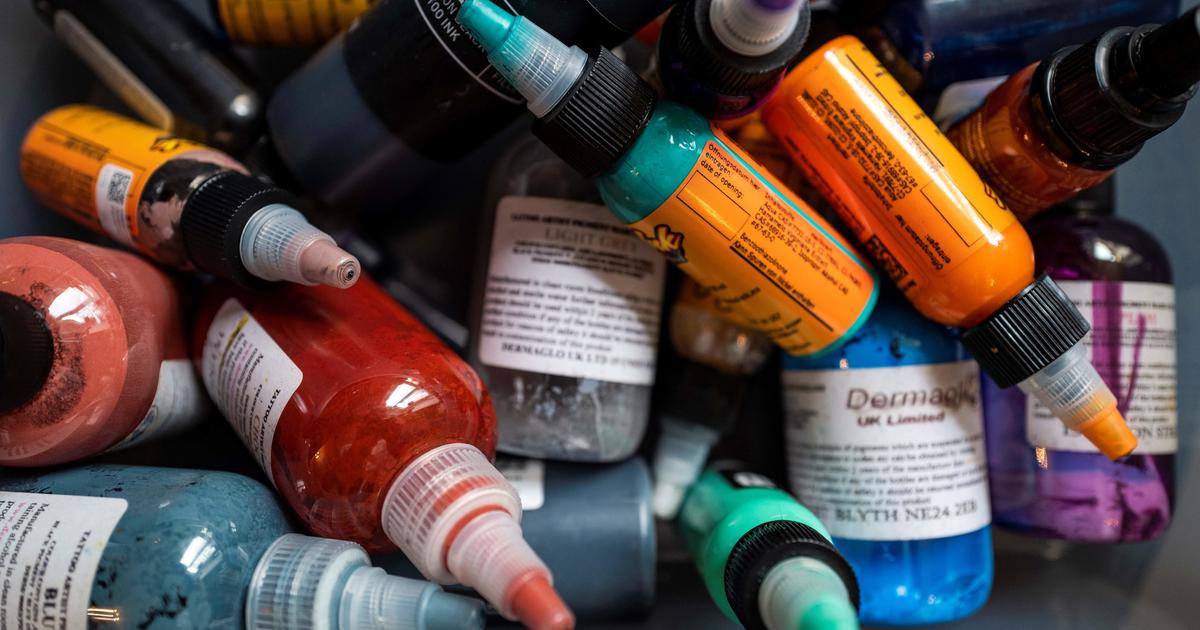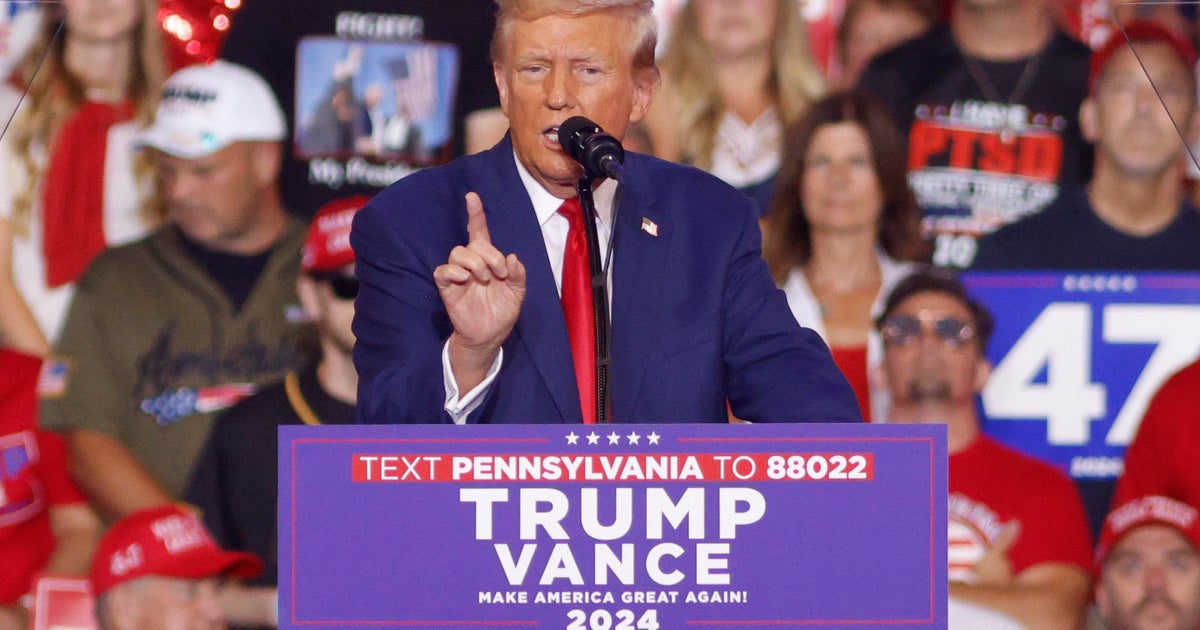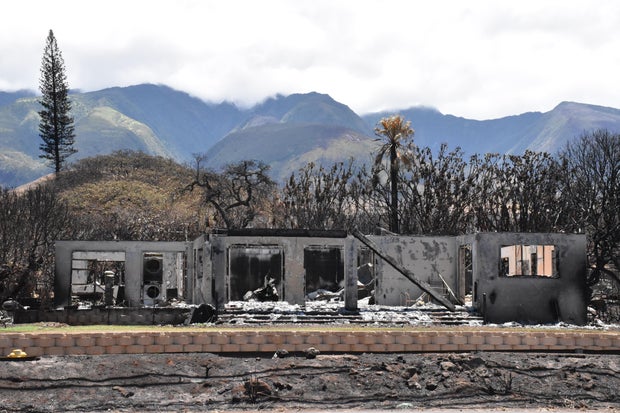CBS News
What’s in tattoo ink? Expert says potentially concerning additives weren’t listed on the packaging

John Swierk is an assistant professor of chemistry at Binghamton University, State University of New York.
Tattoos are an incredibly common form of permanent self-expression that date back thousands of years. Most tattoo artists follow strict health and sanitation regulations, so you might assume that tattoo inks are carefully regulated, too.
But as work done by my team of chemistry researchers suggests, up to 90% of tattoo inks in the U.S. might be mislabeled. This isn’t just a case of a missing pigment or a minor discrepancy. These inks contained potentially concerning additives that weren’t listed on the packaging.
What’s in an ink?
All inks are made up of one or more pigments, which are molecules that give tattoos their color, and some kind of carrier for that pigment. Before the 20th century, pigments used in tattooing included ash, charcoal, minerals or other natural materials. Around the middle of the 20th century, though, tattoo artists started making their own inks using synthetic pigments and dyes.
Today, nearly all pigments used in tattoos are made of synthetic molecules that allow for bright colors – with the exception of white and black pigments.
In the past few decades, tattoo ink manufacturing has shifted from individual artists making their own to large companies manufacturing inks and selling them to artists. My team wanted to figure out whether these inks contained the ingredients advertised, so we analyzed 54 tattoo inks from the U.S. market.
Unlisted ingredients
More than half the inks my research team analyzed contained unlisted polyethylene glycol, also known as PEG. A variety of medical products contain PEG, including laxatives. It can cause allergic reactions, however, and in the case of tattooing, research has suggested that repeated exposure to PEG could lead to kidney failure.
Jü/Wikimedia Commons
We also found propylene glycol in 15 inks, though it wasn’t listed as an ingredient in any of them. Propylene glycol is generally nontoxic and structurally similar to glycerin, which is used to thicken the ink. Even though propylene glycol is safe for most people, some people are highly allergic to it. In fact, it was the American Contact Dermatitis Society’s 2018 Allergen of the Year.
An allergic reaction to propylene glycol can cause a skin rash, itching and blistering.
In several inks, my research team found unlisted ingredients that are common in cosmetics but have not been tested in tattoo inks. These include BHT, dodecane and 2-phenoxyethanol. In low concentrations, 2-phenoxyethanol can be a preservative. But the Food and Drug Administration has warned that it could get passed to infants through breastfeeding and lead to vomiting and dehydration in babies.
Of the 54 inks we analyzed, 29 reported the correct pigments, while the rest either did not report or reported the wrong pigments. This is a known problem in tattoo inks that ink manufacturers have not yet addressed.
Pigment concerns
Studies have found that carbon black, the primary black pigment used in tattooing, can be contaminated with some of the same cancer-causing molecules found in car exhaust and cigarette smoke.
Many red, yellow and orange pigments are azo pigments, which contain two connected nitrogen atoms. These pigments give ink bright, vivid colors, but over time they may break down into carcinogens.
SIMON WOHLFAHRT/AFP via Getty Images
Regulations in Europe prohibit the use of copper-containing pigment blue 15 and pigment green 7, which my work observed to be the only blue and green pigments in the inks we tested. The EU banned these pigments over concern that their use in hair dyes may cause bladder cancer, though researchers haven’t studied that connection in tattoos yet.
A new focus on regulation
The FDA is beginning to pay more attention to what is in tattoo inks. In 2022, Congress passed the Modernization of Cosmetics Regulation Act, or MoCRA, which gave the FDA expanded authority to regulate tattoo inks.
The FDA is still deciding how to implement MoCRA, but the act will require accurate ingredient labeling and expand the FDA’s authority to recall ink. In the past, tattoo inks have very rarely, and only voluntarily, been recalled because of bacterial contamination.
So what does this mean for tattoo clients and artists? Right now, there’s no clear research consensus on whether tattoos are safe or not, as they can cause infection and allergic reactions. Plus, tattoos vary widely in size, color and physical location on the body.
Studies like the one from my lab are an important piece in establishing what is actually in a tattoo, so that researchers can better understand any adverse events, such as long-term allergic reactions, that they might cause.
Understanding what is in ink also helps physicians identify what particular health concerns they should look for in tattooed individuals.
The tattoo-related health issues that researchers do know about come from unskilled artists following poor sanitation protocols. To prevent potential health concerns, those considering a tattoo can work with an experienced and trained artist who follows best practices for hygiene and tattoo aftercare.
This article is republished from The Conversation under a Creative Commons license.
CBS News
Report finds “no evidence” Hawaii officials prepared for deadly wildfire despite warnings

Investigators reviewing the emergency response to last year’s devastating wildfire on Maui said in a report released Friday they found “no evidence” Hawaii officials made preparations for it, despite days of warnings that critical fire weather was about to arrive.
That lack of planning and a misperception of the risk hindered efforts to evacuate the historic town of Lahaina before it burned, claiming 102 lives, the report said.
“While much of Hawaiʻi, including Maui, has a relatively high risk of wildfire occurrence, it appears the perception of this risk—at the local, state, and national levels—is not always aligned with the actual, growing threat wildfires pose to the population and built environment,” the report said. “This gap between risk perception and reality seems to have contributed to a relative underinvestment in wildfire prevention, preparedness, and response capacity over the years.“
A weather forecaster with the National Weather Service emailed fire managers an “unprecedented advance warning” on Aug. 4, 2023, of the danger that would develop on Aug. 8, including extreme winds as a hurricane passed far to the south, according to the report released by the state attorney general. The email stressed the unusual certainty of forecast models and “significant concern” on the part of forecasters.
Zeng Hui/Xinhua via Getty Images
But in the ensuing four days, the report found, there is no evidence that key agencies — the Hawaii Emergency Management Agency, Maui Fire Department, Maui Police and others — developed plans for dealing with severe wildfire risk, such as by having extra staff on duty, stationing emergency vehicles or supplies in high-risk areas, or plotting possible evacuations.
“The strongly worded nature of the email, had it been communicated to fire managers in other states with better developed severity preparedness strategies, could have gained attention and prompted discussion and operational planning,” the report said. “It was a call for State of Hawaii fire managers to prepare for the impending extreme weather.”
The heroic efforts of firefighters and police — who frequently risked their lives, sometimes sprinting door-to-door to warn residents to leave or piling evacuees into their cars to drive them to safety — were undercut by a lack of planning as the deadliest U.S. wildfire in a century destroyed thousands of buildings and caused billions in damages.
Neither Maui County nor the Hawaii Emergency Management Agency immediately responded to emails seeking comment.
“This investigation serves as a wake-up call for the state and county governments to learn from the past and urgently prepare for the future,” Attorney General Anne Lopez said in a statement accompanying the report.
Maui fire commanders discussed the forecast, but “no evidence of pre-event preparedness plans by the MFD were produced,” the report said. The police and fire departments never established a unified incident command post, and as a result it was more difficult to know who was responding to what, or where evacuation routes were blocked by downed trees or power lines.
The report recommends establishing “standard operating procedures for Red Flag and severe fire weather warning conditions, to include: preparing and pre-positioning supplies, equipment, vehicles, and personnel in high-risk areas; ensuring clear and open lines of communication within and among agencies to optimize for rapid and coordinated deployment of resources; and communicating with the public to aid residents in translating the forecasted conditions and risks into evacuation readiness.”
The departments share a mobile command vehicle, but the county did not provide evidence that it was used that day, the report said. Some emergency vehicles didn’t have equipment for clearing roadblocks like fallen trees or locked gates on private roads.
/ Getty Images
With multiple fires burning on Maui before the devastating blaze erupted in the afternoon, police focused on routine duties like traffic control rather than preparing for an evacuation, the report said. Responders lacked an incident action plan, which meant trouble figuring out where to direct resources. The police and fire departments operated separately, hindering communication as the winds toppled utility poles, cutting power and cell service.
And despite the warnings from forecasters, the heads of the county emergency management agency and the Maui Fire Department were both off-island that day, attending conferences in Honolulu. The report said no one appeared to be in charge of strategic resource allocation.
Some of the challenges facing officials and residents were particular to Hawaii and Maui: narrow roads clogged with parked cars and small, inconsistently named dirt roads often blocked by gates.
Many older, wooden homes were designed to resist heat and humidity, not wildfire. They were often separated by less than 6 feet (1.8 meters), and residents frequently left windows open, making it easier for the fire to spread.
Some people died in their cars. Others leaped into the ocean to escape the flames.
The 518-page report, conducted for the Hawaii attorney general’s office by the Fire Safety Research Institute, is the second part of a three-part attempt by officials to understand the tragedy and how best to avoid such disasters in the future.
The review determined that the lack of planning fit a long pattern of apathy to wildfire risk in Hawaii, where tsunamis and hurricanes are considered more pressing dangers, and it was among many factors that set the stage for the catastrophe. The report suggested that fire managers might have focused on the first sentence of the National Weather Service’s email, which noted Hurricane Dora was expected to pass south of the state, rather than make landfall, and thus assumed Hawaii was safe.
Even though a 2018 wildfire in West Maui near Lahaina burned 2,000 acres (810 hectares), destroyed 21 structures and forced 600 people into shelters, the Maui Police Department’s “Natural and Man-Made Disaster Plan” didn’t include wildfires.
The Maui Fire Department has policies for responding to hurricanes — a hurricane watch requires a staffing roster and rotational schedule for relief personnel, for example. But the department had no such policies for high fire danger, the report said.
And even though Maui County passed legislation in 2022 giving the fire department the authority to require property owners to clear vegetation, such as the dry invasive grasses that helped fuel the Aug. 8 fire, under penalty of a $1,000 fine, the county “has not produced any evidence that the MFD has enforced these amendments in the Lahaina area,” the report said.
The report urged Maui police, firefighters, the state land department and Maui emergency managers to work on their procedures and study and implement policies in place in other states.
For example, the report highlights that the “average number of Red Flag Warning days annually in Hawaiʻi is similar to some areas in California where emergency managers and local officials have initiated significant changes to their preparedness efforts over the course of the last 30 years.”
CBS News
FTX founder Sam Bankman-Fried appeals fraud conviction

Lawyers for Sam Bankman-Fried claim in an appeal filed Friday that the imprisoned FTX founder was the victim of a rush to judgment by a public that wrongly believed he was guilty of stealing billions of dollars from his customers and investors before he was even arrested.
The lawyers filed papers with the 2nd U.S. Circuit Court of Appeals asking a three-judge panel to reverse Bankman-Fried’s conviction and assign the case to a new judge for a retrial, saying the trial judge “imposed a draconian quarter-century sentence on this first-time, non-violent offender” after they contend he hurried the jury into reaching a one-day verdict to cap off a complex four-week trial.
“Sam Bankman-Fried was never presumed innocent. He was presumed guilty — before he was even charged. He was presumed guilty by the media. He was presumed guilty by the FTX debtor estate and its lawyers. He was presumed guilty by federal prosecutors eager for quick headlines. And he was presumed guilty by the judge who presided over his trial,” the lawyers wrote.
They said the passing of time has cast Bankman-Fried in a better light.
“From day one, the prevailing narrative — initially spun by the lawyers who took over FTX, quickly adopted by their contacts at the U.S. Attorney’s Office — was that Bankman-Fried had stolen billions of dollars of customer funds, driven FTX to insolvency, and caused billions in losses,” the attorney said.
“Now, nearly two years later, a very different picture is emerging — one confirming FTX was never insolvent, and in fact had assets worth billions to repay its customers. But the jury at Bankman-Fried’s trial never got to see that picture,” they added.
Bankman-Fried, 32, was convicted last November of fraud and conspiracy, a year after his companies collapsed into bankruptcy as investors rushed to withdraw funds. A jury concluded that some of their money had been improperly spent on real estate, investments, celebrity endorsements, political contributions and lavish lifestyles.
At its height, FTX was treated as a pioneer and darling in the emerging cryptocurrency industry, with a Super Bowl advertisement, testimony by Bankman-Fried before Congress and endorsements from celebrities such as quarterback Tom Brady and comedian Larry David.
Bankman-Fried was arrested in December 2022 following his extradition from the Bahamas, just weeks after his company filed for bankruptcy and days after some of his former top executives began cooperating with federal prosecutors. Some of them testified against him at trial.
He initially remained under strict bail conditions at his parents’ home in Palo Alto, California, but Judge Lewis A. Kaplan in Manhattan revoked his bail shortly before the trial after concluding that Bankman-Fried was trying to influence likely witnesses, including an ex-girlfriend who had served as chief executive at Alameda Research, a crypto hedge fund.
The fallen mogul is serving a 25-year sentence after he was sentenced in March in what a prosecutor once described as one of the biggest financial frauds in U.S. history.
A prosecutor’s spokesperson declined to comment Friday.
CBS News
Trump unveils “no tax on overtime pay” policy in Arizona remarks

Former president Donald Trump promised this week to eliminate income taxes on overtime pay if he wins a second term in November.
During remarks on the economy in Tucson, Arizona, Trump unveiled the policy which he said would give “people more of an incentive to work.”
“If you’re an overtime worker, when you’re past 40 hours a week, think of that, your overtime hours will be tax-free,” Trump said.
Any changes to the U.S. tax code require approval from Congress. In 2025, lawmakers will have an opportunity to rewrite the country’s tax laws, when Trump’s 2017 tax laws are set to expire. Trump’s new tax policies — which also include a proposal to end taxes on tips and a proposal that seniors should not pay taxes on social security benefits — are aimed primarily at hourly wage workers, a group that both presidential candidates are courting.
“The people who work overtime are among the hardest working citizens in our country and for too long, no one in Washington has been looking out for them,” Trump said. “They’re police officers, nurses, factory workers, construction workers, truck drivers and machine operators.”
The candidate’s latest tax-riddance proposal would cost $227 billion over 10 years, according to a conservative estimate calculated on Friday by the Tax Foundation, an independent tax policy research organization.
If enacted, the proposal could also spur a shift in those classified as salaried and exempt from overtime to those categorized as hourly workers, Garrett Watson, senior policy analyst at the Tax Foundation, told CBS News. “There are no guardrails on this, so the cost could go up from there,” Watson said.
Added together, Trump’s recent series of tax-exemption proposals “all add up to a multitrillion-dollar hole in deficit financing,” said Watson. “The big question is, to what extent does this make sense as a policy perspective,” he added.
“As an economist, I’m struggling to understand what the rationale is,” offered Janet Holtzblatt, a senior fellow at the Urban-Brookings Tax Policy Center.
Trump’s proposal raises ethical and administrative questions including, “Can the IRS handle this?” said Holzblatt, who previously worked as an analyst in the Congressional Budget Office, the U.S. Treasury and for the Senate Budget Committee.
“It has the possibility of unintended effects — by helping one group of people, you may be harming another group of people,” said Holzblatt, noting the potential impact of how the labor market, in terms of wages and salaries, gets restructured — it gives the employer an incentive to change the base rate, or regular pay.”
Both Hozblatt and Watson said additional details of what Trump’s proposal would entail are needed to have a better grasp of its potential impact.
Vice President Kamala Harris’ campaign calls Trump’s tax pitch is an attempt to “trick” Americans. It noted that the Trump administration in 2019 opted to cover far fewer workers in its overtime pay rule than had been proposed by the prior administration under former President Obama.
“Trump tried to rip away overtime pay for nearly 10 million workers and devastated families,” Joseph Costello, a spokesperson for the Harris campaign, said. “A second term will be even worse: Trump’s Project 2025 Agenda would allow employers to stop paying many workers overtime.”
The Harris campaign’s take was echoed by economist Heidi Shierholz, who leads the Economic Policy Institute, a left-leaning nonprofit think tank.
“Trump’s new playbook is to claim he won’t tax the earnings of the very groups of workers whose earnings he already has a clear record of undermining,” noted Shierholz, who was formerly chief economist at the Department of Labor.
Further, Trump’s proposal could wind up mostly benefiting the highest-paid Americans, according to Shierholz.
“To allow their salaried, overtime-exempt workers to get the tax cut, employers could easily switch them to hourly,” she noted. “It is not unreasonable to imagine that this policy would lead to a world where corporate CEOs earn $4,000 an hour plus $6 million in overtime.”





